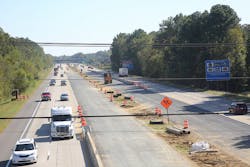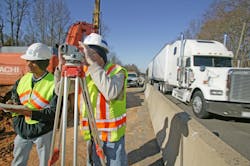A new report jointly authored by the American Association of State Highway and Transportation Officials (AASHTO) and the American Association of Port Authorities (AAPA) is highlighting the need for more freight infrastructure funding – money that Kurt Nagle, AAPA’s president, described as vital to supporting the U.S. economy.
“It will take combination of federal, state, local and private sector resources,” he explained in a conference call with reporters.
“Certainly [president-elect] Trump has talked very vocally about his desire to rebuild infrastructure – discussing an up to $1 trillion [infrastructure] package with Congress,” Nagel said. “At a recent rally, he talked about the need to deepen harbor waterways for larger [cargo] vessels. So I think there is a new recognition by Trump and in Congress that we need to invest not just in overall infrastructure but in transportation – and specifically in freight transportation, if we are to compete internationally.”
The joint national freight infrastructure report – dubbed the The State of Freight II—Implementing the FAST Act and Beyond – also marks the one-year anniversary of the Fixing America’s Surface Transportation or “FAST Act.”
“We are only in the first year of this national freight plan that lays out the investment baseline for multi-model needs,” explained M. Kathleen Broadwater, deputy executive director for the Maryland Port Administration, on the call. “There is an overwhelming need to identify a multi-modal infrastructure funding source.”
Compiling and analyzing results from a combined AASHTO-AAPA survey completed back in November, The State of Freight II report analyzes how states fund freight-specific investments through state-dedicated or discretionary funding, and how these funding sources can potentially work with federal freight investments.
For example, that survey found that 71% of states have state freight plans that they are actively working to make FAST Act compliant. Additionally, 57% of states have targeted more than 6,200 freight projects for inclusion in their state freight plans, while 35% have identified a combined $259 billion in costs for their state’s freight plan projects.
Yet the FAST Act only provides $11 billion over a five-year period to be spent on freight infrastructure projects, noted Bud Wright, AASHTO’s executive director.
“A lot more will be needed just for the over 6,200 freight projects being targeted by the states,” he stressed on the call. “We’re urging lawmakers to provide additional and ongoing resources outside of the highway trust fund [HTF] to fund freight programs.”
“Transportation matters more today than ever,” added David Bernhardt, AASHTO’s president and the Maine DOT commissioner.
“In 2014 total business logistics costs totaled $1.45 trillion according to the State of Logistics report, up 3.1% over the previous year, and this trend will continue,” he said. “That means we must all work together to improve connections between ports, highways, rail, and intermodal facilities.”
Bernhardt added that one of his “top priorities” as AASHTO’s incoming president will be addressing intermodal freight capacity constraints.
Other freight topics considered crucial on the joint report include:
- Having the U.S. Department of Transportation (DOT) continue providing HTF allocations to states for highway freight projects through the National Highway Freight program;
- Having DOT coordinate its Build America Bureau and freight advisory committees with state freight plans to better leverage private-sector investment;
- Reestablish office of multimodal freight transportation within DOT to address domestic and international freight planning needs.
- Requesting that Congress provide additional and ongoing funding resources outside of the HTF for the overall multimodal freight network in such a way it can supplement highway formula dollars and fund discretionary grant programs; and,
- Moving the Harbor Maintenance Tax (HMT) from discretionary to mandatory spending to enable all the revenues from HMT collections to be used for maintenance of deep draft navigation channels and providing more equity.
“The fact that we are talking about freight infrastructure is a good thing – we want that conversation to continue, though, obviously, many details need to be worked out,” AASHTO’s Wright noted. “We will need to work more closely with all the modes and the freight planning rules in the FAST Act will accelerate conversations between agencies and modes. We expect to see that step up.”
About the Author
Sean Kilcarr
Editor in Chief
Sean Kilcarr is a former longtime FleetOwner senior editor who wrote for the publication from 2000 to 2018. He served as editor-in-chief from 2017 to 2018.

